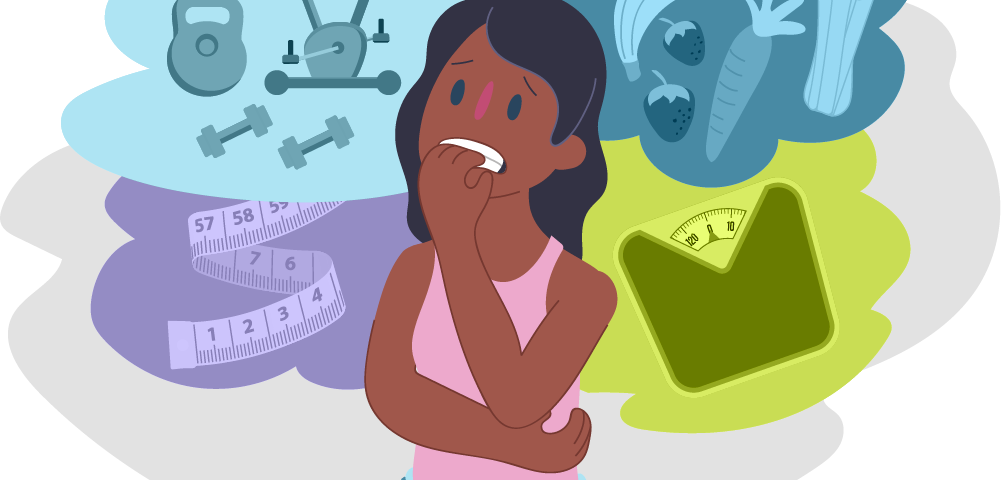Although the term eating is in the name, eating disorders are about more than food. They’re complex mental health conditions that often require the intervention of medical and psychological experts to alter their course. Please beware of your eating style, your diet method, and your belief.
These disorders are described in the American Psychiatric Association’s Diagnostic and Statistical Manual of Mental Disorders, fifth edition (DSM-5).
What are eating disorders?
Eating disorders are mental health conditions marked by an obsession with food or body shape. They can affect anyone but are most prevalent among young women.
What Causes Them?
Experts believe that eating disorders may be caused by a variety of factors.
1.Genetics
Twin and adoption studies involving twins who were separated at birth and adopted by different families provide some evidence that eating disorders may be hereditary.
2. Personality Traits
In particular, neuroticism, perfectionism, and impulsivity are three personality traits often linked to a higher risk of developing an eating disorder.
3. Cultural Ideas
Other potential causes include perceived pressures to be thin, cultural preferences for thinness, and exposure to media promoting such ideals.
4. Brain Biology
More recently, experts have proposed that differences in brain structure and biology may also play a role in the development of eating disorders. In particular, levels of the brain messengers serotonin and dopamine may be factors.
6 of the most common types of eating disorders and their symptoms.
1.Anorexia Nervosa

People with anorexia generally view themselves as overweight, even if they’re dangerously underweight. They tend to constantly monitor their weight, avoid eating certain types of foods, and severely restrict their calories.
Common symptoms of anorexia nervosa include :
- being considerably underweight compared with people of similar age and height
- very restricted eating patterns
- intense fear of gaining weight or persistent behaviors to avoid gaining weight, despite being underweight
- a relentless pursuit of thinness and unwillingness to maintain a healthy weight
- a heavy influence of body weight or perceived body shape on self-esteem
- a distorted body image, including denial of being seriously underweight
Anorexia is officially categorized into two subtypes — the restricting type and the binge eating and purging type.
Individuals with the restricting type lose weight solely through dieting, fasting, or excessive exercise.
Individuals with binge eating and purging type may binge on large amounts of food or eat very little. In both cases, after they eat, they purge using activities like vomiting, taking laxatives or diuretics, or exercising excessively.
2. Bulimia Nervosa
People with bulimia nervosa eat large amounts of food in short periods of time, then purge. They fear gaining weight despite being at a normal weight.
Symptoms may appear very similar to those of the binge eating or purging subtypes of anorexia nervosa. However, individuals with bulimia usually maintain a relatively normal weight, rather than becoming underweight.
Common symptoms of bulimia nervosa include:
- recurrent episodes of binge eating with a feeling of lack of control
- recurrent episodes of inappropriate purging behaviors to prevent weight gain
- self-esteem overly influenced by body shape and weight
- a fear of gaining weight, despite having a normal weight
3. Binge Eating Disorder
Individuals with this disorder have symptoms similar to those of bulimia or the binge eating subtype of anorexia.
People with binge eating disorder regularly and uncontrollably consume large amounts of food in short periods of time. Unlike people with other eating disorders, they do not purge.
Common symptoms of binge eating disorder include :
- eating large amounts of foods rapidly, in secret, and until uncomfortably full, despite not feeling hungry
- feeling a lack of control during episodes of binge eating
- feelings of distress, such as shame, disgust, or guilt, when thinking about the binge-eating behavior
- no use of purging behaviors, such as calorie restriction, vomiting, excessive exercise, or laxative or diuretic use, to compensate for the binging
People with binge eating disorder often have overweight or obesity. This may increase their risk of medical complications linked to excess weight, such as heart disease, stroke, and type 2 diabetes.
4. Pica

Individuals with pica tend to crave and eat non-food substances. This disorder may particularly affect children, pregnant women, and individuals with mental disabilities. Eat such as ice, dirt, soil, chalk, soap, paper, hair, cloth, wool, pebbles, laundry detergent, or cornstarch.
Individuals with pica may be at an increased risk of poisoning, infections, gut injuries, and nutritional deficiencies. Depending on the substances ingested, pica may be fatal. However, to be considered pica, the eating of non-food substances must not be a normal part of someone’s culture or religion. In addition, it must not be considered a socially acceptable practice by a person’s peers.
5. Rumination Disorder
Rumination disorder can affect people at all stages of life. People with the condition generally regurgitate the food they’ve recently swallowed. Then, they chew it again and either swallow it or spit it out.
It describes a condition in which a person regurgitates food they have previously chewed and swallowed, re-chews it, and then either re-swallows it or spits it out.
This disorder can develop during infancy, childhood, or adulthood. In infants, it tends to develop between 3–12 months of age and often disappears on its own. Children and adults with the condition usually require therapy to resolve it.
If not resolved in infants, rumination disorder can result in weight loss and severe malnutrition that can be fatal.
Adults with this disorder may restrict the amount of food they eat, especially in public. This may lead them to lose weight and become underweight.
6. Avoidant/ restrictive food intake disorder
Avoidant/restrictive food intake disorder (ARFID) is a new name for an old disorder.
The term replaces what was known as a “feeding disorder of infancy and early childhood,” a diagnosis previously reserved for children under 7 years old.
Although ARFID generally develops during infancy or early childhood, it can persist into adulthood. What’s more, it’s equally common among men and women.
Individuals with this disorder experience disturbed eating either due to a lack of interest in eating or distaste for certain smells, tastes, colors, textures, or temperatures.
Common symptoms of ARFID include :
- avoidance or restriction of food intake that prevents the person from eating sufficient calories or nutrients
- eating habits that interfere with normal social functions, such as eating with others
- weight loss or poor development for age and height
- nutrient deficiencies or dependence on supplements or tube feeding
Source:www.healthline.com



